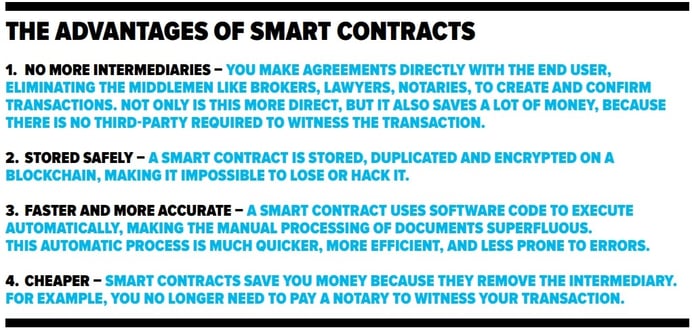Tokens and Smart Contracts Redesign Existing Supply Chains
The rise of the internet and big data unleashed public access to a torrent of information. Blockchain is the next wave of this technological revolution. It took some time for the market to embrace the possibilities of the internet and big data, during which, they evolved and matured. The same phenomenon is happening with blockchain.
This article interprets and compares blockchain to the rise of the internet and big data and explains the core elements of its application. It also looks at its potential impact on society.
Technology in Search of an Application
The internet brought us general access to information while big data made it possible to store and process massive amounts of combined data sources. Blockchain promises to make transactional data available in a decentralized system.
The big data trend came on quickly. The demand for its application already existed, it just wasn’t possible technologically yet. When computing power, cheap data storage, and distributed file systems became available, the endless possibilities of data analytics moved into reach.
With blockchain, it is the other way around. The technology is there, but the application for business is not that apparent. Blockchain overturns existing supply chains and business models. It democratizes services by putting them on a blockchain, thereby cutting out organizations that have a considerable influence in their markets.
Before we go into more detail, let’s take a quick look at what a blockchain is, precisely.
What is a Blockchain
A blockchain refers to a decentralized ledger that administratively stores all transactions across a network of computers.
The first application of blockchain technology and the concept of a decentralized ledger was with the first crypto-currency, Bitcoin. However, blockchain has many other applications beyond Bitcoin, such as smart contracts, financial and administrative information, and other transactional data.
Within a blockchain, all the transactional data is made publicly available. Parties that are involved in a transaction remain private because transactions are made under pseudonyms, called “Bitcoin addresses.” So, although an individual's private information is not visible, information like volume, time, and involved addresses is publicly available.
Block Explorers
On the web, there are several “block explorers” that allow you to view information about blocks, addresses, and transactions on the Bitcoin blockchain.
A block explorer shows the latest blocks that have been added to the blockchain. It also provides information about the generated hashes and the distribution of the block reward to the miners who helped solve it. Some explorers even provide charts and statistics about the network activity.
Smart Contacts
One of the most promising applications of blockchain technology is smart contracts. Moving contract execution from service providers like lawyers, notaries, and insurance companies to a smart contract makes it possible to exchange money, property, shares, or anything of value in a transparent, conflict-free way while avoiding intermediaries (example here).
A smart contract holds the rules and penalties involved in the agreement, as well as the enforcement of its obligations. It uses if/then logic to execute next steps, like the payout of a reward or token. When the contract is available on a (public) blockchain, hundreds of others watch its execution and ensure that it’s done correctly and accurately.
 Figure 1. The advantages of smart contracts.
Figure 1. The advantages of smart contracts.
Tokens
On a blockchain, tokens play a vital role. They represent actual assets. Smart contracts enable the creation of tokens with complex behaviors attached to them. The token concept is central to most innovations developed with blockchain technology.
As part of the incentive scheme of a blockchain, tokens hold a relative value that represents a proof of stake or work. For example, a token can represent a currency, but it could also represent an insurance policy, credit for a taxi ride, the right of ownership of a house, the license to use software, pay-per-use access to care, etcetera.
Types of tokens
Not every token is equal. As blockchain evolves, new types of tokens and ways to sort them arise. The token value system includes:
1. Intrinsic, native or built-in tokens
This type of token is used on blockchains like Bitcoin, Ether, etc. It serves as an incentive to reward miners that validate blocks of transactions, or as spam prevention, by making all transactions paid.
2. Application tokens
Some blockchains, like Ethereum or a derivative like Status, make it possible to issue tokens from within an application, for example as the result of the execution of a smart contract.
3. Asset-backed tokens
Asset-backed tokens are the digital equivalent to physical assets. The physical asset could be gold, for example. The issuing party puts the asset-backed token onto a blockchain for later redemption. To claim the underlying asset, you send your token to the issuer who then sends you the underlying asset.
Permissionless or Permissioned
There are two kinds of blockchains: permissionless and permissioned ledger systems. The difference between the two is that a permissionless ledger systems requires some sort of incentive mechanism for the block validators to do what they are supposed to do.
Well-known public blockchains, like Bitcoin or Ethereum, are thought of as “permissionless ledgers.” These ledgers have an incentive mechanism in place, such as tokens, that guarantees that block validators are doing their jobs as expected.
Then there are “permissioned” ledger systems, which can be owned by any kind of group, people or organizations, such as a federation, consortium, or a private organization. The block validators or miners in these kinds of systems are all identified members. The control of membership is in the hands of a central authority, making it unnecessary to use tokens.
SInce decentralization is one of the core characteristics of a blockchain, it’s debatable as to whether or not a permissioned ledger system should be referred to as a blockchain.
The Decentralized Autonomous Organization
The structure of traditional organizations is centralized. It involves many layers of management to coordinate and enforce processes. New organizational structures, like agile and the Spotify-model, have recently been introduced, but they are still very centrally organized, because they also still require contracts and the exchange of lots of information to ensure proper decision making.
Blockchain enables a new organizational form to emerge: the decentralized autonomous organization (DAO). Unlike traditional companies, the DAO is comprised of groups of people who work in “tribes,” according to fully transparent rules. These rules are written in the software and incentivized by tokens.

Figure 2. Traditional Organizations vs. Decentralized Autonomous Organisation.
New Regulatory Frameworks
Technologically, blockchains and tokens could reinvent ownership. However, governments and other policymakers will need to determine how to regulate DAOs before this new organizational form can be widely accepted. The caveat, regulation must not come at the expense of the unique purpose and function of blockchain technology.
Summary
Most supply chains consist of intermediaries who administrate and monitor the execution of contracts. Blockchain technology makes it possible to overthrow the traditional supply chain by embedding these kind of steps within a decentralized ledger. Smart contracts are one of the critical elements that makes this possible. Smart contracts contain per-defined and engineered rules that execute contracts and conduct transactions transparently, in a more accurate, timely, and cost-efficient way.
The possibilities of blockchain, smart contracts, and tokens lead to new organizational forms, often referred to as a decentralized and autonomous organization (DAO). A DAO consists of people working together in tribes that are held together by a common incentive, often represented by a token. Members of a blockchain earn rewards for doing jobs, such as validating blocks of transactions. In addition to being a technological development, blockchain is also very much a societal development, because government policy and jurisdiction are not ready today for DAOs.
This article is part of the report Urgent Future - Blockchain.







